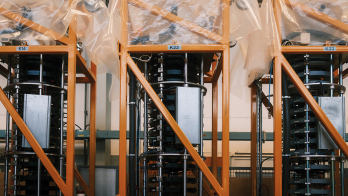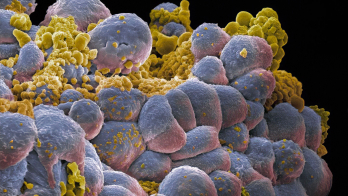
After a three-year hiatus, protons are once again circulating in the LHC, as physicists make final preparations for the start of Run 3. At the beginning of October, a beam of 450 GeV protons made its way from the Super Proton Synchrotron (SPS) down the TI2 beamline towards Point 2, where it struck a dump block and sprayed secondary particles into the ALICE experiment (see image). Beam was also successfully sent down the TI8 transfer line, which meets the LHC near to where the LHCb experiment is located.
Today, counter-rotating protons were finally injected into the LHC, marking the latest milestone in the reawakening of CERN’s accelerator complex, which closed down at the end of 2018 for Long Shutdown 2 (LS2). Two weeks of beam tests are planned, along with first low-energy collisions in the experiments, before the machine is shut down for a 3-4 month maintenance period. Meanwhile, the experiments are continuing to ready themselves for more luminous Run-3 operations.
Final countdown
Beams have been back at CERN since the spring. After a comprehensive two-year overhaul, the Proton Synchrotron (PS) accelerated its first beams on 4 March and has recently started supplying experiments in the newly refurbished East Area and at the new ELENA ring at the Antimatter Factory. Connecting the brand-new Linac4 to the upgraded PS Booster (which also serves ISOLDE) was a major step in the upgrade programme. Together, they now provide the PS with a 2 GeV beam, 0.6 GeV up from before, for which the 60-year-old machine had to be fitted out with refurbished magnets, new beam-dump systems, instrumentation, and upgraded RF and cooling systems.
When the LHC comes back online for physics in May 2022, it will not only be more luminous, but it will also operate at higher energies
LS2 saw an even greater overhaul of the SPS, including the addition of a new beam-dump system, a refurbished RF system that now includes the use of solid-state amplifier technology, and a major overhaul of the control system. Combined with the LHC Injectors Upgrade project (the main focus of LS2), the accelerator complex is now primed for more intense beams, in particular for the High-Luminosity LHC (HL-LHC) later this decade.
The first bunch was injected from the PS into the SPS on 12 April, building up to “LHC-like” beams of up to 288 bunches a few weeks later. The SPS delivers beams to all of CERN’s North Area experiments, which include a new facility, NA65, approved in 2019 to investigate fast-neutron production for better understanding of the background in underground neutrino experiments. It also drives the AWAKE experiment, which performs R&D for plasma-wakefield acceleration and entered its second run in July with the goal of demonstrating acceleration gradients of 1 GV/m while preserving the beam quality. The restart of North Area experiments will also see pilot runs for new experiments such as AMBER (the successor of COMPASS) and NA64μ (NA64 running with muon beams).
Brighter and more powerful
When the LHC comes back online for physics in May 2022, it will not only be more luminous (with up to 1.8 × 1011 protons per bunch compared to 1.3–1.4 × 1011 during Run 2), but it will also operate at higher energies. This year, the majority of the LHC’s 1232 dipole magnets were trained to carry 6.8 TeV proton beams, compared to 6.5 TeV before, which involves operating with a current of 11.5 kA (with a margin of 0.1 kA). Following the beam tests this autumn, magnet training for the final two of the machine’s eight sectors will take place during a scheduled maintenance period from 1 November to 21 February. After that, the LHC tunnel and experiment areas will be closed for a two-week-long “cold checkout”, with beam commissioning commencing on 7 March and first stable beams expected during the first week of May.
Meanwhile, the LHC experiments are continuing to ready their detectors for the bumper Run-3 data harvest ahead: at least 160 fb–1 (as for Run 2) to ATLAS and CMS; 25 fb–1 to LHCb (compared to 6 fb–1 in Run 2); and 7.5 nb–1 of Pb–Pb collisions to ALICE (compared to 1.3 nb–1 in Run 2). The higher integrated luminosities expected for ALICE and LHCb are largely possible thanks to the ability of their upgraded detectors to handle the Run-3 data rate, with LHCb teams currently working around the clock to ensure their brand-new sub-detectors are in place. New forward-experiments, FASER, FASERν and SND@LHC, which aim to make the first observations of collider neutrinos and open new searches for feebly interacting particles, are also gearing up to take first data when the LHC comes back to life.
“The injector performance reached in 2021 is just the start of squeezing out the potential they have been given during LS2, paving the way for the HL-LHC, but also benefiting the LHC’s performance during Run 3,” says Rende Steerenberg, head of the operations group. “Having beam back in the entire complex and routinely providing the experimental facilities with physics is testimony to the excellent and hard work of many people at CERN.”








